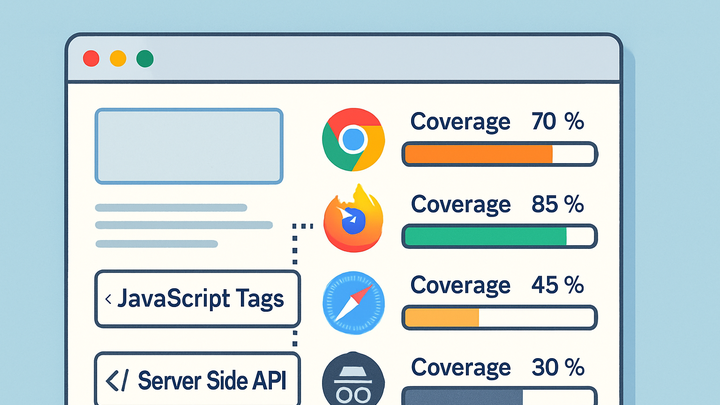Published on 2025-06-28T03:50:25Z
What is Tracking Coverage? Examples of Tracking Coverage in Analytics
Tracking Coverage refers to the proportion of user interactions and events that analytics tools successfully capture on your website or application. It assesses the completeness of data collection by accounting for missing hits due to browser restrictions, ad blockers, network issues, or implementation errors. High Tracking Coverage is essential for reliable user behavior insights, accurate conversion attribution, and informed decision making. Low coverage can lead to skewed KPIs, misguided optimizations, and compliance risks. Modern solutions like cookie-free analytics (e.g., PlainSignal) and server-side tagging via GA4 Measurement Protocol help mitigate client-side limitations and improve overall coverage. Continuously monitoring and optimizing Tracking Coverage ensures that your analytics data remains robust, comprehensive, and trustworthy.
Tracking coverage
Tracking Coverage measures the percentage of user interactions successfully recorded by analytics tools, highlighting gaps due to blockers or misconfigurations.
Importance of Tracking Coverage
Tracking Coverage is crucial because it directly impacts the validity of your analytics insights. Incomplete data can distort user journey analysis and conversion metrics, leading to poor business decisions.
-
Data accuracy
High coverage ensures that visitor counts, pageviews, and event metrics truly reflect user behavior without systematic gaps.
-
Conversion optimization
Reliable coverage allows you to accurately attribute marketing campaigns and optimize funnels based on actual user actions.
-
Regulatory compliance
Monitoring coverage helps you demonstrate compliance with data protection regulations by tracking consented versus blocked interactions.
Factors Affecting Tracking Coverage
Several elements influence how many events your analytics setup captures. Understanding these factors helps in diagnosing and fixing coverage gaps.
-
Browser restrictions & ad blockers
Modern browsers and extensions often block third-party scripts or cookies, preventing client-side analytics tags from firing.
-
Implementation errors
Incorrect tag placement or misconfigured triggers can lead to missing hits.
-
Missing tags
Pages without the correct snippet won’t send any data to your analytics backend.
-
Incorrect configuration
Wrong container IDs or trigger settings can prevent events from being recorded.
-
-
Privacy regulations
GDPR, CCPA, and other laws can block tracking until explicit consent is given, reducing initial coverage.
Measuring Tracking Coverage
Accurately measuring coverage helps identify data gaps and validate improvements.
-
Tag assistant & debugging tools
Use browser extensions like GA4 DebugView or custom tag assistants to verify which hits reach the analytics endpoint.
-
Coverage metrics
Calculate the ratio of recorded events to expected events (e.g., page loads) to quantify coverage percentage.
-
Server-side vs client-side comparison
Compare client-side hits against server-side forwarded events to spot discrepancies.
Strategies to Improve Tracking Coverage
Implementing certain techniques can help you capture a higher percentage of user interactions.
-
Cookie-free analytics solutions
Tools like PlainSignal use simple scripts that avoid relying on cookies, bypassing many client-side blocks.
-
Server-side tagging
Send events directly from your server to GA4 Measurement Protocol to reduce dependency on client environments.
-
Set up a server endpoint
Configure your backend to receive event payloads and forward them to GA4.
-
Send events via http
Use the Measurement Protocol API to post event data from server processes.
-
-
Tag management best practices
Use a central tag manager to ensure consistent deployment and version control of analytics code.
Example Tracking Code Snippets
Below are code examples demonstrating how to implement PlainSignal and GA4 Measurement Protocol for improved coverage.
-
PlainSignal implementation
<link rel="preconnect" href="//eu.plainsignal.com/" crossorigin /><script defer data-do="yourwebsitedomain.com" data-id="0GQV1xmtzQQ" data-api="//eu.plainsignal.com" src="//cdn.plainsignal.com/plainsignal-min.js"></script> -
GA4 measurement protocol example
fetch('https://www.google-analytics.com/mp/collect?measurement_id=G-XXXXX&api_secret=YOUR_SECRET', { method: 'POST', body: JSON.stringify({ client_id: '12345.67890', events: [{ name: 'page_view' }] }) });
